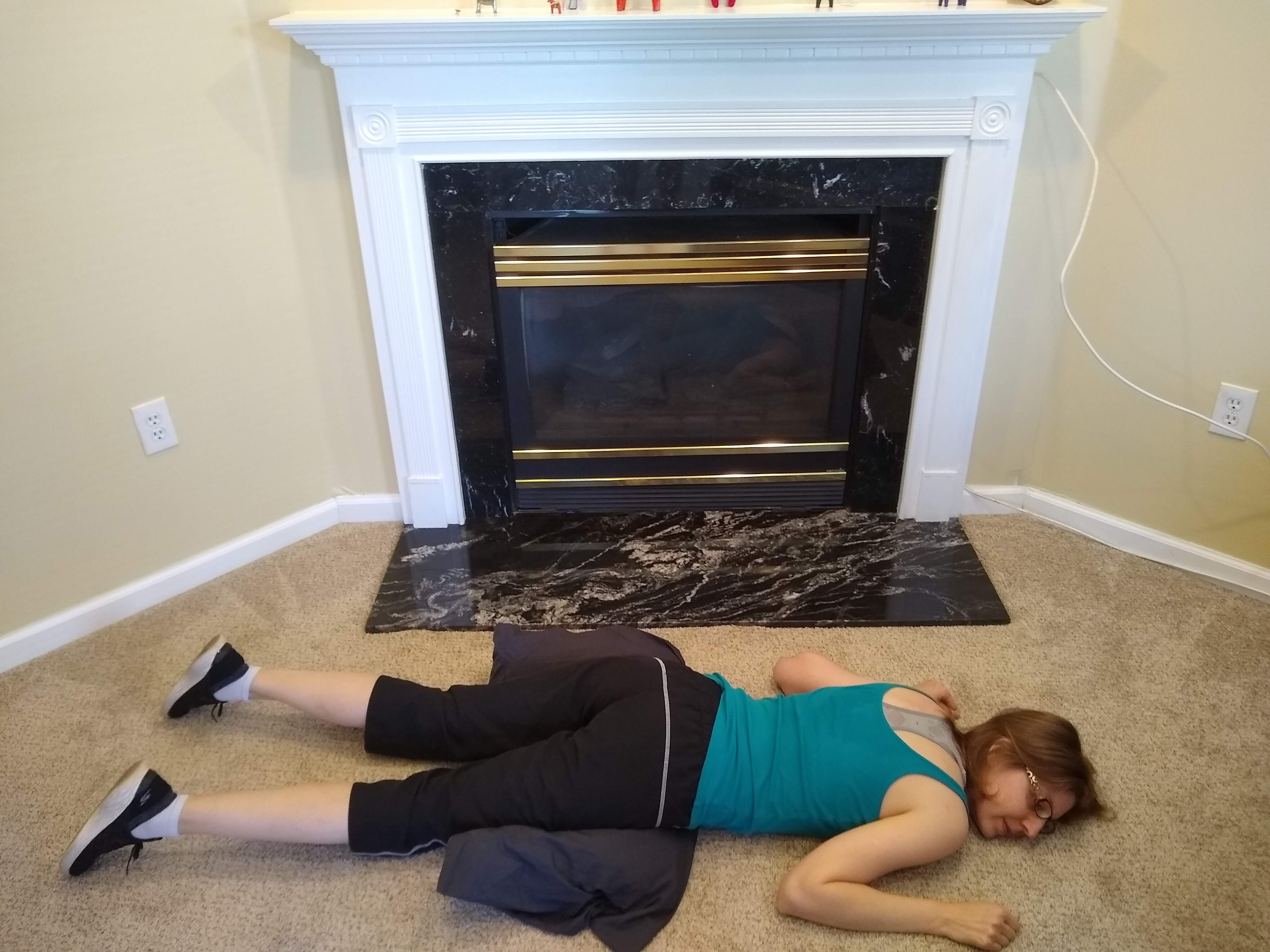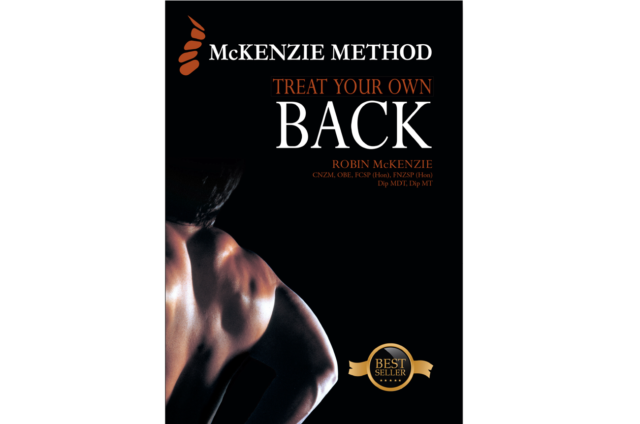When I was doing my first round of physical therapy for sciatica, the therapist put me on a table, and instructed me to up into cobra pose over and over again. This, I learned, was a McKenzie exercise.
For the next few months, I continued to do versions of it during physical therapy, on a yoga mat at home, and in the first aid room at work.
This was my first live encounter with the McKenzie method, but once it was on my radar, I couldn’t seem to avoid bumping into it. Ideas about the postural origins of back pain, centralization, and exercise therapy (which usually included some version of extension exercises) seemed to dominate the thinking of professionals and patients alike.
After years of getting secondhand versions of his advice from websites, forums, and patient stories, I picked up Robin McKenzie’s book, Treat Your Own Back, to see what the man himself had to say.
How to Read Treat Your Own Back
A few pages in, I realized I had to decide how to interpret the contents of Treat Your Own Back. Should I take it as a proper treatment manual? An alternative medicine treatise? A crackpot theory to be disproved?
No, I decided. None of those seemed like the right approach. Instead, I decided to read it as a classic of back pain treatment.
Hopefully, a biology student who picks up On the Origin of Species doesn’t expect to find the most accurate and up-to-date information about evolution inside. Instead, they will find a seminal and insightful work that had a major influence on both science and the public. I decided to set similar expectations.
What I found in Treat Your Own Back was not the most current science. Indeed, very few of the recommendations were backed up by published research. Some of the recommendations are now outdated, or have been refined into better methods. Still, as I read on, it was clear I was reading the work of an insightful and empathetic practitioner.
On the Origin of How to Treat Your Own Back
Robin McKenzie was born in Auckland, New Zealand, in 1931. After graduating from the New Zealand School of Physiotherapy, he opened his own clinic. He was all of 23 years old.
Three years later, in 1956, he had an experience that caused a paradigm shift in his thinking. As the story goes, Mr. Smith was a back pain patient who came to McKenzie’s clinic. Just before his session, McKenzie instructed Mr. Smith to go into the treatment room and lie face-down on the table.
However, McKenzie hadn’t realized that the head of the table was raised. Mr. Smith followed instructions anyway, and assumed a backbend to lie on the table. When McKenzie came into the room, he was alarmed to see Mr. Smith in such an awkward position.
He was even more shocked when Mr. Smith reported he felt better than he had in three weeks, since his back pain began.
This was a lightbulb moment for McKenzie. He started assigning different postural and exercise prescriptions to his patients, and took careful notes on their progress and responses. He used these observations to hone a comprehensive method for treating musculoskeletal disorders.
Treat Your Own Back was first published in 1980, and went through seven editions before McKenzie’s death in 2013. The most recent edition – the one I read – was published in 2010.
Why Your Back Hurts, According to McKenzie
After a myth-busting chapter, McKenzie goes into an overview of spinal anatomy, and offers his views on the causes of back pain.
According to McKenzie, back pain comes from overstretched ligaments and soft tissues in the spine. To illustrate this concept, he recommends readers bend a finger back as far as it will go, and keep it that way.
You might feel okay at first, but if you keep your finger stretched back for minutes, and then hours, pain will set in. If you ignore it, you will eventually injure your ligaments and soft tissues, and the pain will continue even after you stop this stupid exercise.
McKenzie writes: “Pain produced by overstretching in this manner is common and arises particularly when we develop poor postural habits. Whenever we remain in a relaxed position, whether standing, sitting or lying, prolonged overstretching can easily occur.” (pg. 21)
He even coined a term for this kind of chronic overstretching: Postural Syndrome.
He then proceeded to explain disc bulges and herniations, and noted that these can also cause serious pain. He suggested a new term for this type of pain as well: Derangement Syndrome.
McKenzie also asserted that once these types of injuries heal, the scar tissue that forms around them can tighten, leading to more pain when stretched. “This can create the impression that you are still injured whereas in reality healing is complete and you are pulling on the scar itself.” (pg. 25)
Beyond that, McKenzie doesn’t dive into the types of tissue damage that cause back pain. There isn’t much need, since his treatment program is recommended for all back pain patients.
How to Treat Back Pain, According to McKenzie
So, how do you treat your own back?
McKenzie’s program focuses on posture, and postural corrections. In particular, he advises patients to be ever watchful of their lumbar lordosis, since losing it will be more painful than losing a wallet or purse. He includes instructions on how to sit, stand, and lift properly.
Patients aren’t excused from postural vigilance, even if they’re sleeping. To protect their lumbar lordosis in bed, McKenzie advises patients to sleep with a special roll that looks like a thin inner tube, or a thick belt, strapped around the waist.
The exercises McKenzie recommends are postural interventions. His first exercises (which he also recommends during acute episodes) create extension in the spine.
The first exercise is as simple as lying face-down with one’s head to their side. Subsequent exercises provide new ways for patients to get into deep backbends.
Once a patient’s back pain is under control, McKenzie recommends adding exercises that create flexion in the spine. This seemed like an odd reversal to me, seeing as how McKenzie was so focused on maintaining lordosis. He went on to explain that these exercises are meant to increase flexibility by stretching the newly laid-down scar tissue.
A Perceptive Practitioner
As I read through, my impression was that McKenzie was a perceptive observer who had a good eye for what caused pain, and what relieved it.
He realized that sitting, especially while slouched, could trigger pain. So could vacuuming, gardening, digging, and other tasks that involved lots of bending. He realized that bending forward was particularly dangerous in the early morning. He advised patients on how to cough or sneeze without triggering an episode.
These pain triggers all sounded familiar, since I had noticed each of them myself. Yet, none of the doctors I’ve visited could explain how these pieces of information fit into the overall pattern.
When it came to treatment, McKenzie noticed that many patients felt better with their backs in extension. He also discovered that using back supports helped people sit better, drive better, and sleep better.
By the time my own back problems began, I took it for granted that I could find a lumbar support cushion for any occasion. My main challenge was narrowing the options down to one.
I never questioned where this theory came from, or who had popularized it. I did know that using a back support cushion in my car and office chair made sitting more tolerable.
McKenzie reported that, “As few seats or chairs provide adequate support for the lower back, I found it necessary to provide my patients with a portable lumbar roll that could be used in the car, the lounge seat and at the dining table. When I realised that a support was vital for my patients if they were to remain pain-free, I found that no-one knew of anything suitable to purchase. Therefore, in the early days before The Original McKenzie® range of rolls went into commercial production, my wife made them herself on our kitchen table. Now I believe there are hundreds of other companies worldwide manufacturing lumbar rolls for back support.” (pg. 40–41)
Indeed, The Original McKenzie® still sells a complete line of support cushions.
Shortcomings
Though McKenzie cites a few studies in his book, references are scant. In the absence of any direct explanation, and given the scant biographical details I found on the McKenzie Method website, I understand he came up with his exercises and treatment program by watching his patients, and seeing how they reacted.
McKenzie wasn’t spending time in a lab, dissecting tissue samples and examining them under a microscope. Nor was he sorting people into treatment and placebo groups. There were pros and cons to this approach.
One con is that he tends to overgeneralize about the causes and treatment of back pain. Everyone is assigned the same exercise program, regardless of whether their pain is caused by stenosis, spondylolisthesis, or a herniated disc.
Although I myself have a herniated disc, I felt a visceral reaction on behalf of those with back problems that make them intolerant of extension. I can’t imagine a spondylolisthesis patient would enjoy a program that mixes extreme extension with extreme flexion.
On the other hand, I felt a visceral reaction on behalf of myself when I read the prescriptions for flexion exercises. Trying to touch my toes is a sure-fire way for me to spike my sciatica. Although I’m four years into this back episode, I don’t think I’ll “progress” to this particular exercise anytime soon.
The extension exercises prescribed by McKenzie may be useful for people with disc herniations. However, he takes things to extremes. I cringed when I read about the contraption he had designed, which helps bend people backwards repeatedly.
McKenzie explained that, “This machine, named REPEX, can continuously move the low back many hundreds of times if necessary without patient exertion.” (pg. 101)
Although I did my share of McKenzie exercises, they never seemed to help me much. It wasn’t until later that I learned I had a rare type of disc herniation, which involved an underhooked sciatic nerve.
Instead of pushing myself into cobra pose, I now lay face-down with a pillow under my hips, so that my butt sticks up in the air. Once I found this posture, I realized why therapists make such a fuss about posture in the first place. Within three minutes, I felt a dramatic improvement.
I don’t blame McKenzie for failing to pick up on this subtlety. My case is the exception, not the rule. But I do think this incident highlights the shortcomings of McKenzie’s approach. His one-size-fits-all plan may be helpful for the average person with disc-related pain, but it will leave others feeling confused, disappointed, or barely able to move.

Conclusions
When I finished reading, I asked myself: If a friend asked for a book recommendation about treating back pain, would I suggest Treat Your Own Back?
No, I decided. In that case, I would still recommend Back Mechanic. That book includes more information on various causes of back pain, a thorough evaluation section, and better scientific grounding for its recommendations. It’s an excellent first book for beginners.
However, if someone wanted to know more about the history of back pain treatment, or an explanation for their therapist’s recommendation, I would wholeheartedly recommend Treat Your Own Back.
You might even say…I would bend over backwards to recommend it.
